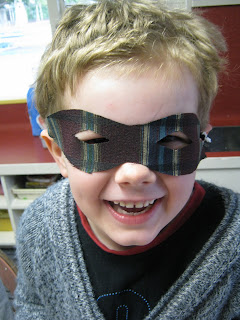With Halloween only a few days away we have made these incredibly cute scary hanging bats from Martha Stewart. This week we have been reading a Bat Poem (with our super scared bat voices), and practicing our reading of the 'at' rime.
We are now 'at' experts.
We are now 'at' experts.
Trace around the bat template. (Great pencil grip!)
Cut out two black paper bats.
Glue the bats to each side of the peg. (We painted our pegs earlier in the week.)
Glue on googly eyes, and your bat is ready.
We hung our bats from a net, but they would look great clipped to wire or along a curtain.
Amazing bat facts:
Some of the amazing things we learnt that make bats special.
- Bats are nocturnal, they sleep during the day and are awake at night.
- Bats hang around upside down and wrap their wings around themselves to keep warm.
- There are over 1000 species of bats.
- Baby bats cuddle together in a nursery.
- Baby bats drink their mothers milk.
- Bats use sonar to fly in the dark.
- Bats are mammals.
As part of our phonics program I concentrate on explicitly teaching phonics and linking it to our reading and writing. This week, with 4 lovely brand-new five-year-olds starting, I decided to concentrate on teaching what sounds the letters that 'a' and 't' make and how to write these letters correctly.
Explicitly teaching phonics enables children beginning school to be able to feel successful reading and writing unknown words. I use the Yolanda Soryl Phonics Program and Jolly Phonics. We have phonics four times a week, each session is about 20 minutes long and teaches children to hear, read, and write the sounds (phonemes) that they can hear in words.
We also concentrate on roboting (sounding out) words and writing these down. When we robot words we get our "robot arms ready" (elbows bent at 90 degrees), and move one arm at a time for each phoneme in the word, after the final phoneme we sweep one arm across our body and say the word together. So, 'bat' would be "b-a-t, bat"
I always try to end each session by reminding the children that "Now you know this sound, you can use it in your reading and writing".
I love it when children come up to me during the day and point out a letter or digraph that we have been practicing that they spotted by themselves. One sweetheart pointed out, with great delight at their cleverness, every 'th' digraph they read in every single one of their reading books for a week. (Now that is a successful lesson!)
Explicitly teaching phonics enables children beginning school to be able to feel successful reading and writing unknown words. I use the Yolanda Soryl Phonics Program and Jolly Phonics. We have phonics four times a week, each session is about 20 minutes long and teaches children to hear, read, and write the sounds (phonemes) that they can hear in words.
We also concentrate on roboting (sounding out) words and writing these down. When we robot words we get our "robot arms ready" (elbows bent at 90 degrees), and move one arm at a time for each phoneme in the word, after the final phoneme we sweep one arm across our body and say the word together. So, 'bat' would be "b-a-t, bat"
I always try to end each session by reminding the children that "Now you know this sound, you can use it in your reading and writing".
I love it when children come up to me during the day and point out a letter or digraph that we have been practicing that they spotted by themselves. One sweetheart pointed out, with great delight at their cleverness, every 'th' digraph they read in every single one of their reading books for a week. (Now that is a successful lesson!)





































